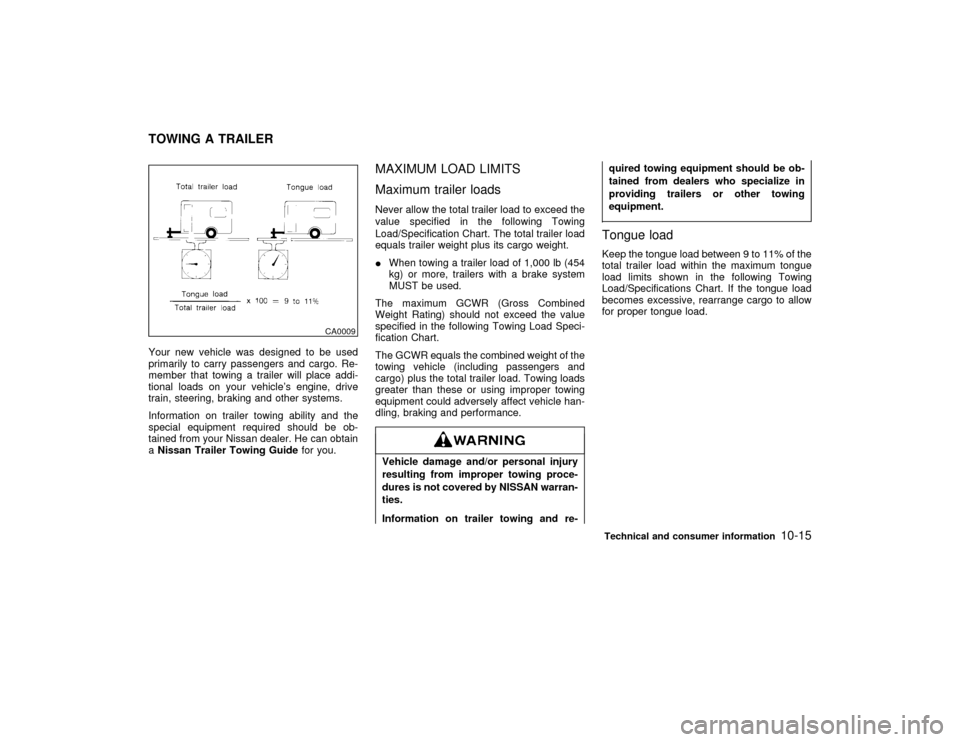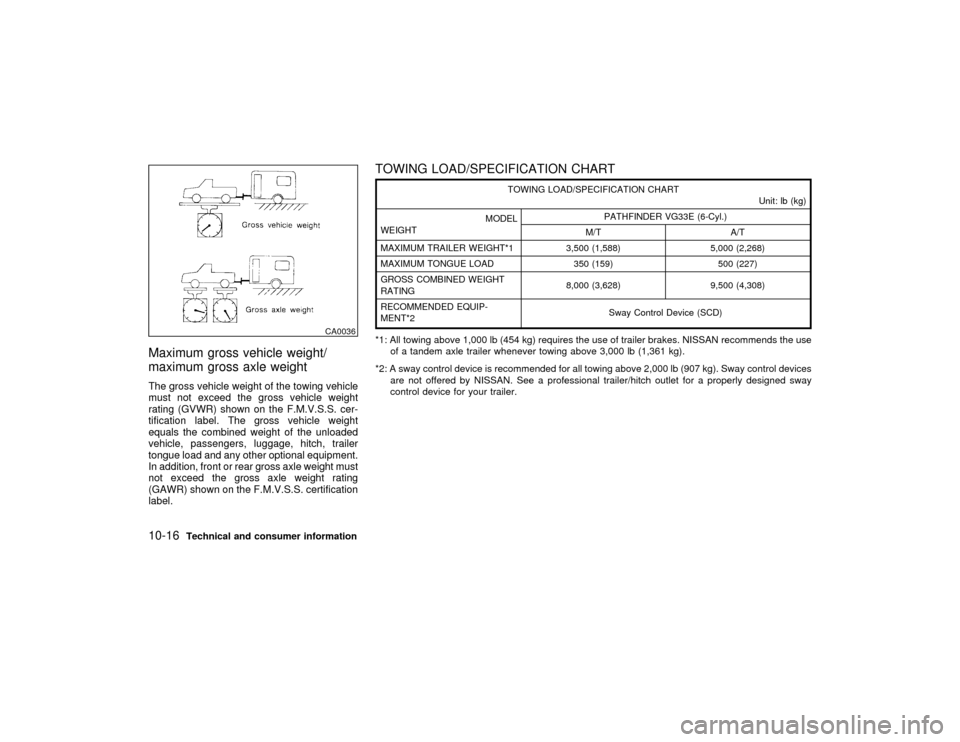tow NISSAN PATHFINDER 1999 R50 / 2.G Owner's Manual
[x] Cancel search | Manufacturer: NISSAN, Model Year: 1999, Model line: PATHFINDER, Model: NISSAN PATHFINDER 1999 R50 / 2.GPages: 274, PDF Size: 2.34 MB
Page 239 of 274
![NISSAN PATHFINDER 1999 R50 / 2.G Owners Manual Schedule 1Abbreviations: R = Replace I = Inspect. Correct or replace if necessary. L = Lubricate [ ]: At the mileage intervals onlyMAINTENANCE OPERATIONMAINTENANCE INTERVAL
Perform at number of miles, NISSAN PATHFINDER 1999 R50 / 2.G Owners Manual Schedule 1Abbreviations: R = Replace I = Inspect. Correct or replace if necessary. L = Lubricate [ ]: At the mileage intervals onlyMAINTENANCE OPERATIONMAINTENANCE INTERVAL
Perform at number of miles,](/img/5/634/w960_634-238.png)
Schedule 1Abbreviations: R = Replace I = Inspect. Correct or replace if necessary. L = Lubricate [ ]: At the mileage intervals onlyMAINTENANCE OPERATIONMAINTENANCE INTERVAL
Perform at number of miles, kilometers
or months, whichever comes first.Miles´1,000 3.75 7.5 11.25 15 18.75 22.5 26.25 30 33.75 37.5 41.25 45 48.75 52.5 56.25 60
(km´1,000) (6) (12) (18) (24) (30) (36) (42) (48) (54) (60) (66) (72) (78) (84) (90) (96)
Months 3 6 9 12 15 18 21 24 27 30 33 36 39 42 45 48
Chassis and body maintenance
Brake lines & cablesIIII
Brake pads, rotors, drums & liningsIIIIIIII
Automatic transmission & transfer fluid,
manual transmission & differential gear oil
(exc. LSD)See NOTE (1)IIII
Limited-slip differential (LSD) gear oil See NOTE (1)IRIR
Steering gear, linkage & transfer gear, axle & suspension partsIIIIIIII
Drive shaft boots (
) IIIIIIII
Propeller shaft See NOTE (2)LLLLLLLL
Front wheel bearing grease (4x2)II
Front wheel bearing grease (
) See NOTE (3)IRIR
Exhaust systemIIIIIIII
Supplemental air bag system and supple-
mental side air bag systems (if so
equipped)See NOTE (4)
Automatic Speed Control Device (ASCD) vacuum hosesIIII
NOTE: (1) If towing a trailer, using a camper or a car-top carrier, or driving on rough or muddy roads, change (not just inspect) oil at every 30,000 miles(48,000 km)
or 24 months except for LSD. Change LSD gear oil every 15,000 miles (24,000 km) or 12 months.
(2) The propeller shaft should be re-greased after being immersed in water.
(3) If operating frequently in water, replace grease every 3,750 miles (6,000 km) or 3 months.
(4) Inspect the supplemental air bag system 10 years after the date of manufacture noted on the F.M.V.S.S. certification label.
9-8
Maintenance
Z
01.1.22/R50-D/V5
X
Page 244 of 274

10 Technical and consumer informationCapacities and recommended fuel/lubricants ......... 10-2
Fuel recommendation ............................................. 10-4
Engine oil and oil filter recommendation................. 10-6
Recommended SAE oil viscosity number ............... 10-7
Air conditioning system refrigerant and lubricant
recommendations .................................................... 10-8
Specifications .......................................................... 10-9
Engine ..................................................................... 10-9
Tires and wheels ................................................... 10-10
Dimensions and weights ....................................... 10-10
When traveling or registering your vehicle in another
country................................................................... 10-11
Vehicle identification ............................................. 10-11
Vehicle identification number (VIN) plate.............. 10-11
Vehicle identification number (Chassis number) .. 10-11
Engine serial number ............................................ 10-12F.M.V.S.S. certification label ................................. 10-12
Emission control information label ........................ 10-12
Tire placard ........................................................... 10-13
Air conditioner specification label.......................... 10-13
Vehicle loading information ................................... 10-13
Terms .................................................................... 10-13
Determining vehicle load capacity ........................ 10-14
Loading tips ........................................................... 10-14
Towing a trailer ..................................................... 10-15
Maximum load limits.............................................. 10-15
Towing load/specification chart ............................. 10-16
Towing safety ........................................................ 10-17
Emission control system warranty ........................ 10-18
Reporting safety defects (US only) ....................... 10-19
Readiness for inspection/maintenance (I/M) test (US
only)....................................................................... 10-19
Z
01.1.22/R50-D/V5
X
Page 247 of 274

FUEL RECOMMENDATIONYour vehicle is designed to operate on
unleaded gasoline with an octane rating of
at least 87 AKI (Anti-Knock Index) number
(Research octane number 91).Using a fuel other than that specified
could adversely affect the emission con-
trol devices and systems, and could
also affect the warranty coverage.
Under no circumstances should a
leaded gasoline be used since this will
damage the three way catalyst.Reformulated gasolineSome fuel suppliers are now producing refor-
mulated gasolines. These gasolines are spe-
cially designed to reduce vehicle emissions.
NISSAN supports efforts towards cleaner air
and suggest that you use reformulated gaso-
line when available.Gasoline containing oxygenatesSome fuel suppliers sell gasoline containing
oxygenates such as ethanol, MTBE andmethanol with or without advertising their pres-
ence. Nissan does not recommend the use of
fuels of which the oxygenate content and the
fuel compatibility for your Nissan cannot be
readily determined.
If you use oxygenate-blend gasoline, please
take the following precautions as the usage of
such fuels may cause vehicle performance
problems and/or fuel system damage.
IThe fuel should be unleaded and have
an octane rating no lower than that rec-
ommended for unleaded gasoline.
IIf an oxygenate-blend, excepting a
methanol blend, is used, it should con-
tain no more than 10% oxygenate.
(MTBE may, however, be added up to
15%.)
IIf a methanol blend is used, it should
contain no more than 5% methanol (me-
thyl alcohol, wood alcohol). It should
also contain a suitable amount of appro-
priate cosolvents and corrosion inhibi-
tors. If not properly formulated with ap-
propriate cosolvents and corrosion
inhibitors, such methanol blends may
cause fuel system damage and/or ve-
hicle performance problems. At this
time, sufficient data is not available to
ensure that all methanol blends are suit-able for use in Nissan vehicles.
If any undesirable driveability problems such
as engine stalling and hard hot starting are
experienced after using oxygenate-blend fu-
els, immediately change to a non-oxygenate
fuel or a fuel with a low blend of MTBE.
Take care not to spill gasoline during refu-
eling. Gasoline containing oxygenates can
cause paint damage.
Aftermarket fuel additivesNISSAN does not recommend the use of any
fuel additives (i.e.: fuel injector cleaner, octane
booster, intake valve deposit removers, etc.)
which are sold commercially. Many of these
additives intended for gum, varnish or deposit
removal may contain active solvents or similar
ingredients that can be harmful to the fuel
system and engine.Octane rating tipsIn most parts of North America, you should use
unleaded gasoline with an octane rating of at
least 87 AKI (Anti-Knock Index) number. How-
ever, you may use unleaded gasoline with an
octane rating as low as 85 AKI (Anti-Knock
Index) number in these high altitude areas
[over 4,000 ft (1,219 m)] such as: Colorado,
Montana, New Mexico, Utah, Wyoming, north-
10-4
Technical and consumer information
Z
01.1.22/R50-D/V5
X
Page 250 of 274

ing, use the genuine oil filter or its equivalent
for the reason described in change intervals.Change intervalsThe oil and oil filter change intervals for your
engine are based on the use of the specified
quality oils and filters. Oil and filter other than
the specified quality, or oil and filter change
intervals longer than recommended could re-
duce engine life. Damage to engines caused
by improper maintenance or use of incorrect
oil and filter quality and/or viscosity is not
covered by the new Nissan vehicle warranties.
Your engine was filled with a high quality
engine oil when it was built. You do not have to
change the oil before the first recommended
change interval. Oil and filter change intervals
depend upon how you use your vehicle. Op-
eration under the following conditions may
require more frequent oil and filter changes.
Ð repeated short distance driving at cold out-
side temperatures,
Ð driving in dusty conditions,
Ð extensive idling,
Ð towing a trailer.
RECOMMENDED SAE OIL
VISCOSITY NUMBER
SAE 5W-30 viscosity oil is preferred for all
temperatures. SAE 10W-30 viscosity oil
may be used if the ambient temperature is
above 0ÉF (þ18ÉC).
TI0008-A
Technical and consumer information
10-7
Z
01.1.22/R50-D/V5
X
Page 258 of 274

Your new vehicle was designed to be used
primarily to carry passengers and cargo. Re-
member that towing a trailer will place addi-
tional loads on your vehicle's engine, drive
train, steering, braking and other systems.
Information on trailer towing ability and the
special equipment required should be ob-
tained from your Nissan dealer. He can obtain
aNissan Trailer Towing Guidefor you.
MAXIMUM LOAD LIMITS
Maximum trailer loadsNever allow the total trailer load to exceed the
value specified in the following Towing
Load/Specification Chart. The total trailer load
equals trailer weight plus its cargo weight.
IWhen towing a trailer load of 1,000 lb (454
kg) or more, trailers with a brake system
MUST be used.
The maximum GCWR (Gross Combined
Weight Rating) should not exceed the value
specified in the following Towing Load Speci-
fication Chart.
The GCWR equals the combined weight of the
towing vehicle (including passengers and
cargo) plus the total trailer load. Towing loads
greater than these or using improper towing
equipment could adversely affect vehicle han-
dling, braking and performance.Vehicle damage and/or personal injury
resulting from improper towing proce-
dures is not covered by NISSAN warran-
ties.
Information on trailer towing and re-quired towing equipment should be ob-
tained from dealers who specialize in
providing trailers or other towing
equipment.
Tongue loadKeep the tongue load between 9 to 11% of the
total trailer load within the maximum tongue
load limits shown in the following Towing
Load/Specifications Chart. If the tongue load
becomes excessive, rearrange cargo to allow
for proper tongue load.
CA0009
TOWING A TRAILER
Technical and consumer information
10-15
Z
01.1.22/R50-D/V5
X
Page 259 of 274

Maximum gross vehicle weight/
maximum gross axle weightThe gross vehicle weight of the towing vehicle
must not exceed the gross vehicle weight
rating (GVWR) shown on the F.M.V.S.S. cer-
tification label. The gross vehicle weight
equals the combined weight of the unloaded
vehicle, passengers, luggage, hitch, trailer
tongue load and any other optional equipment.
In addition, front or rear gross axle weight must
not exceed the gross axle weight rating
(GAWR) shown on the F.M.V.S.S. certification
label.
TOWING LOAD/SPECIFICATION CHART
TOWING LOAD/SPECIFICATION CHART
Unit: lb (kg)
MODEL
WEIGHTPATHFINDER VG33E (6-Cyl.)
M/T A/T
MAXIMUM TRAILER WEIGHT*1 3,500 (1,588) 5,000 (2,268)
MAXIMUM TONGUE LOAD 350 (159) 500 (227)
GROSS COMBINED WEIGHT
RATING8,000 (3,628) 9,500 (4,308)
RECOMMENDED EQUIP-
MENT*2Sway Control Device (SCD)
*1: All towing above 1,000 lb (454 kg) requires the use of trailer brakes. NISSAN recommends the use
of a tandem axle trailer whenever towing above 3,000 lb (1,361 kg).
*2: A sway control device is recommended for all towing above 2,000 lb (907 kg). Sway control devices
are not offered by NISSAN. See a professional trailer/hitch outlet for a properly designed sway
control device for your trailer.
CA0036
10-16
Technical and consumer information
Z
01.1.22/R50-D/V5
X
Page 260 of 274

TOWING SAFETY
Trailer hitchCheck the towing capacity of your receiver
type frame mounted hitch. Choose a proper
hitch for your vehicle and trailer. A genuine
NISSAN trailer hitch is available from your
NISSAN dealer (Canada only). Make sure the
trailer hitch is securely attached to the vehicle,
to help avoid personal injury or property dam-
age due to sway caused by crosswinds, rough
road surfaces or passing trucks.ISpecial hitches which include frame
reinforcements are required for tow-
ing above 2,000 lb (907 kg). Suitable
Genuine NISSAN hitches for pickup
truck and Pathfinder models are
available at your Nissan dealer.
IDo not use axle-mounted hitches.
IDo not modify the vehicle exhaust
system, brake system, etc. when the
hitch is installed. After the hitch is
removed, seal the bolt holes to pre-
vent exhaust fumes, water or dustfrom entering the passenger com-
partment.
ICheck regularly to make sure that all
trailer hitch mounting bolts are se-
curely fastened.
ITo reduce the possibility of additional
damage if your vehicle is struck from
the rear, where practical, remove the
hitch when not in use. Remove the
receiver when not in use.
Tire pressuresIWhen towing a trailer, inflate the vehicle
tires to the recommended cold tire pressure
indicated on the tire placard (affixed to the
glove box lid).
ITrailer tire condition, size, load rating and
proper inflation pressure should be in ac-
cordance with the trailer and tire manufac-
turers' specifications.Safety chainsAlways use a suitable chain between your
vehicle and the trailer. The chain should be
crossed and should be attached to the hitch,
not to the vehicle bumper or axle. Be sure toleave enough slack in the chain to permit
turning corners.
Trailer lightsTrailer lights should comply with Federal
and/or local regulations.
When wiring vehicle for towing connection,
connect stop and tail light pickup into the
vehicle electrical circuit at point between
the sensor and stop light switch or light
switch.Trailer brakesIf your trailer is equipped with a braking sys-
tem, make sure it conforms to Federal and/or
local regulations and that it is properly in-
stalled.Never connect a trailer brake system
directly to the vehicle brake system.Trailer towing tipsIn order to gain skill and an understanding of
the vehicle's behavior, you should practice
turning, stopping and backing up in an area
which is free from traffic. Steering stability andTechnical and consumer information
10-17
Z
01.1.22/R50-D/V5
X
Page 261 of 274

braking performance will be somewhat differ-
ent than under normal driving conditions.
IAlways secure items in the trailer to prevent
load shift while driving.
IAvoid abrupt starts, acceleration or stops.
IAvoid sharp turns or lane changes.
IAlways drive your vehicle at a moderate
speed.
IAlways block the wheels on both vehicle
and trailer when parking. Parking on a
slope is not recommended; however, if you
must do so, and if your vehicle is equipped
with automatic transmission, first block the
wheels and apply the parking brake, and
then move the transmission selector lever
into the P position. If you move the selector
lever to the P position before blocking the
wheels and applying the parking brake,
transmission damage could occur.
IWhen going down a hill, shift into a lower
gear and use the engine braking effect.
When ascending a long grade, downshift
the transmission to a lower gear and reduce
speed to reduce chances of engine over-
loading and/or overheating.
However, for long steep grades, do not stay in1st or 2nd gear when driving above 35 MPH
(56 km/h).
IIf the engine coolant rises to an extremely
high temperature when the air conditioning
system is on, turn off the air conditioner.
Coolant heat can be additionally vented by
opening the windows, switching the fan
control to high and setting the temperature
control to the HOT position.
ITrailer towing requires more fuel than nor-
mal circumstances.
IAvoid towing a trailer for the first 500 miles
(800 km).
IHave your vehicle serviced more often than
at intervals specified in the recommended
Maintenance Schedule.
When towing a trailer, change oil in the
transmission more frequently. See the
Maintenance Schedule.Your NISSAN is covered by the following
emission warranties.
For US:
1) Emission Defects Warranty
2) Emissions Performance Warranty
For CANADA:
Emission Control System Warranty
Details of these warranties may be found with
other vehicle warranties in your Warranty In-
formation and Maintenance Log Booklet which
comes with your NISSAN. If you did not re-
ceive a Warranty Information and Mainte-
nance Log Booklet or it becomes lost, you may
obtain a replacement by writing.
INissan North America, Inc. Consumer Af-
fairs Department P.O. Box 191 Gardena.
CA 90248-0191
INissan Canada Inc. 5290 Orbitor Drive
Mississauga, Ontario, L4W 4Z5
EMISSION CONTROL SYSTEM
WARRANTY
10-18
Technical and consumer information
Z
01.1.22/R50-D/V5
X
Page 270 of 274

Remote keyless entry, (See multi-remote control
system) ............................................................. 3-5
Reporting safety defects (USA only) ............ 10-19
Rollover ............................................................. 5-4
SSafety
Child seat belts.......................................... 1-24
Infiniti Communicator operating ................ 2-42
Reporting safety defects (USA only)....... 10-19
Towing safety .......................................... 10-17
Seat adjustment
Front manual seat adjustment .................... 1-2
Rear seat adjustment .................................. 1-6
Seat belt extenders......................................... 1-30
Seat belt hook................................................. 1-28
Seat belt maintenance .................................... 1-30
Seat belt warning light .................................... 1-22
Seat belt warning light and chime .................. 2-10
Seat belt(s)
Child safety................................................ 1-24
Infants and small children ......................... 1-24
Injured persons.......................................... 1-25
Larger children .......................................... 1-24
Precautions on seat belt usage ................ 1-23
Pregnant women ....................................... 1-24
Seat belt cleaning........................................ 7-4
Seat belts .................................................. 1-22
Three-point type with retractor .................. 1-25
Two-point type without retractor (rear center
lap belt)...................................................... 1-28
Seat(s)
Heated seats ............................................. 2-23Seats ........................................................... 1-2
Security system (See theft warning)............... 2-14
Servicing air conditioner................... 4-3, 4-9, 4-11
Shifting, Manual transmission ......................... 5-13
Shoulder belt height adjustment, For front
seats ............................................................... 1-27
Side air bag system (See supplemental side air
bag system) .................................................... 1-10
Spark plugs ..................................................... 8-15
Speedometer .................................................... 2-3
Spot lights ....................................................... 2-35
Starting
Before starting the engine ........................... 5-8
Jump starting ............................................... 6-8
Precautions when starting and driving ........ 5-2
Push starting ............................................. 6-10
Starting the engine ...................................... 5-8
Steering
Power steering fluid................................... 8-11
Power steering system .............................. 5-24
Tilting steering wheel ................................ 3-14
Storage ........................................................... 2-25
Sun shade....................................................... 2-35
Sun visors ....................................................... 3-14
Sunroof, Automatic sunroof ............................ 2-34
Supplemental air bag system ......................... 1-16
Supplemental air bag warning labels ............. 1-20
Supplemental air bag warning light ....... 1-20, 2-10
Supplemental restraint system ....................... 1-10
Precautions on supplemental restraint
system ....................................................... 1-10
Supplemental side air bag system ................. 1-10
Switch
Fog light switch ......................................... 2-22Glass hatch and outside mirror defogger
switch......................................................... 2-18
Hazard warning flasher switch .................. 2-22
Headlight switch ........................................ 2-18
Ignition switch .............................................. 5-6
Ignition switch automatic transmission
models ......................................................... 5-7
Ignition switch manual transmission
models ......................................................... 5-6
Overdrive switch ........................................ 5-12
Turn signal switch ..................................... 2-21
T
Tachometer ....................................................... 2-4
Temperature display ......................................... 2-6
Temperature gauge, Engine coolant temperature
gauge ................................................................ 2-4
Three way catalyst ............................................ 5-3
Tilting steering wheel ...................................... 3-14
Tire
Flat tire ........................................................ 6-2
Tire chains ................................................. 8-28
Tire placard ............................................. 10-13
Tire pressure ............................................. 8-26
Tire rotation ............................................... 8-28
Type of tires .............................................. 8-27
wheel/tire size.......................................... 10-10
Wheels and tires ....................................... 8-26
Top tether strap child restraints ...................... 1-40
Towing
Tow truck towing ....................................... 6-11
Towing a trailer........................................ 10-15
Towing load/specification chart ............... 10-15
Z
01.1.22/R50-D/V5
X
11-5
Page 271 of 274

Towing safety .......................................... 10-17
Trailer towing ................................................ 10-15
Transceiver, Integrated HomeLink
Universal
Transceiver ..................................................... 2-37
Transfer case shifting procedures .................. 5-21
Transmission
Automatic transmission fluid (ATF) ............. 8-9
Driving with manual transmission ............. 5-13
Transmitter, (See multi-remote control
system) ............................................................. 3-5
Traveling or registering your vehicle in another
country .......................................................... 10-11
Turn signal switch ........................................... 2-21
U
Underbody cleaning .......................................... 7-3
VVanity mirror light ............................................ 2-37
Vehicle
Dimensions and weights ......................... 10-10
Identification number (VIN) ..................... 10-11
Loading information ................................. 10-13
Recovery, (freeing a stuck vehicle)........... 6-14
Ventilators ......................................................... 4-2
WWarning, Hazard warning flasher switch ........ 2-22
Warning labels, Air bag warning labels .......... 1-20
Warning light
Air bag warning light ........................ 1-20, 2-10Brake warning light.................................... 2-11
Door ajar.................................................... 2-10
Seat belt warning light and chime............. 2-10
Warning/indicator lights and chimes ................. 2-9
Warranty, Emission control system
warranty ........................................................ 10-18
Washer switch
Rear window wiper and washer switch ..... 2-17
Windshield wiper and washer switch ........ 2-16
Washing ............................................................ 7-2
Waxing .............................................................. 7-2
Weights (See dimensions and weights) ....... 10-10
Wheel/tire size .............................................. 10-10
Wheels and tires ............................................. 8-26
Window washer fluid ....................................... 8-12
Window(s), Cleaning ......................................... 7-3
Windshield wiper and washer switch.............. 2-16
Wiper
Blades........................................................ 8-17
Rear window wiper and washer switch ..... 2-17
Windshield wiper and washer switch ........ 2-16
Z
01.1.22/R50-D/V5
X
11-6